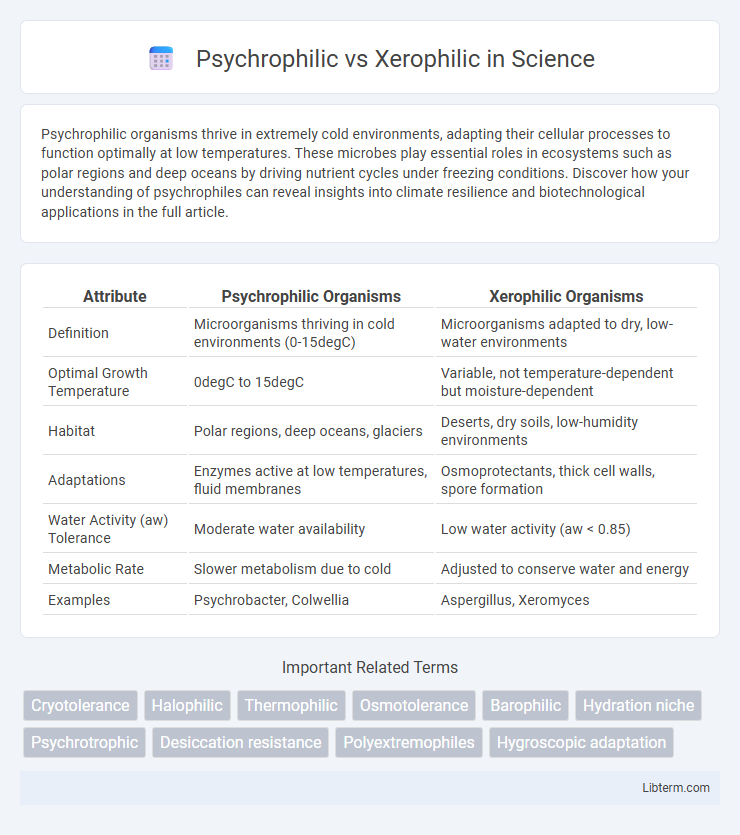Psychrophilic organisms thrive in extremely cold environments, adapting their cellular processes to function optimally at low temperatures. These microbes play essential roles in ecosystems such as polar regions and deep oceans by driving nutrient cycles under freezing conditions. Discover how your understanding of psychrophiles can reveal insights into climate resilience and biotechnological applications in the full article.
Table of Comparison
| Attribute | Psychrophilic Organisms | Xerophilic Organisms |
|---|---|---|
| Definition | Microorganisms thriving in cold environments (0-15degC) | Microorganisms adapted to dry, low-water environments |
| Optimal Growth Temperature | 0degC to 15degC | Variable, not temperature-dependent but moisture-dependent |
| Habitat | Polar regions, deep oceans, glaciers | Deserts, dry soils, low-humidity environments |
| Adaptations | Enzymes active at low temperatures, fluid membranes | Osmoprotectants, thick cell walls, spore formation |
| Water Activity (aw) Tolerance | Moderate water availability | Low water activity (aw < 0.85) |
| Metabolic Rate | Slower metabolism due to cold | Adjusted to conserve water and energy |
| Examples | Psychrobacter, Colwellia | Aspergillus, Xeromyces |
Introduction to Psychrophilic and Xerophilic Organisms
Psychrophilic organisms thrive in extremely cold environments, typically below 15degC, exhibiting adaptations such as antifreeze proteins and flexible enzymes to maintain cellular function. Xerophilic organisms specialize in surviving in environments with very low water activity, such as dry or saline habitats, by developing mechanisms to retain moisture and stabilize cellular structures. Both psychrophiles and xerophiles demonstrate unique biochemical and physiological traits that enable survival under extreme temperature and desiccation stress.
Defining Psychrophiles: Adaptation to Cold Environments
Psychrophiles are microorganisms adapted to thrive in cold environments, typically at temperatures below 15degC, with optimal growth around 0-10degC. Their cellular structures include specialized enzymes and membrane lipids that maintain flexibility and functionality in freezing conditions. Unlike xerophiles, which survive in dry habitats by reducing water activity, psychrophiles have evolved mechanisms to prevent ice crystal formation and sustain metabolic processes in permafrost, glaciers, and deep ocean waters.
Xerophiles: Thriving in Extreme Dryness
Xerophiles are specialized microorganisms that thrive in environments with extremely low water activity, such as deserts and dried food products. These organisms exhibit unique adaptations like producing protective solutes and having robust cell membranes to prevent water loss and maintain cellular function. Understanding xerophiles is crucial for applications in food preservation, biotechnology, and studying life in arid ecosystems.
Environmental Niches: Where Do Psychrophiles and Xerophiles Live?
Psychrophiles thrive in permanently cold environments such as Arctic and Antarctic ice, deep ocean waters, and alpine glaciers, where temperatures remain below 15degC. Xerophiles are adapted to extremely dry habitats like deserts, salty soils, and dried foods, surviving with minimal water availability. Both microorganisms occupy specialized ecological niches that demand unique physiological adaptations to cope with cold temperatures or desiccation stress.
Physiological Adaptations of Psychrophiles
Psychrophiles exhibit physiological adaptations such as producing cold-active enzymes with high catalytic efficiency at low temperatures, maintaining membrane fluidity through increased unsaturated and polyunsaturated fatty acids, and synthesizing antifreeze proteins that prevent ice crystal formation. These modifications enable psychrophilic microorganisms to thrive in permanently cold environments like polar regions and deep ocean waters. Unlike xerophiles, which adapt to extreme dryness, psychrophiles specifically optimize cellular processes for survival and growth at temperatures typically below 15degC.
Xerophilic Survival Mechanisms
Xerophilic organisms survive in low-water environments by accumulating compatible solutes such as glycerol and trehalose, which help retain cellular moisture and stabilize proteins and membranes. Their cell walls and membranes exhibit increased rigidity and reduced permeability to minimize water loss. These adaptations enable xerophiles to thrive in habitats with extreme dryness, contrasting psychrophiles that primarily adapt to cold environments through antifreeze proteins and membrane fluidity maintenance.
Metabolic Differences: How They Obtain Energy
Psychrophilic organisms rely on metabolic processes adapted to cold environments, utilizing enzymes that function efficiently at low temperatures to break down organic compounds and extract energy. Xerophilic organisms employ metabolic pathways suited for low-water conditions, often synthesizing protective solutes like trehalose to stabilize enzymes and maintain energy production despite osmotic stress. The distinct metabolic adaptations in psychrophiles and xerophiles reflect their strategies for energy acquisition under extreme temperature and moisture limitations, respectively.
Industrial and Biotechnological Applications
Psychrophilic microorganisms thrive in cold environments and are exploited in biotechnological applications such as cold-active enzyme production for food processing, bioremediation in cold regions, and pharmaceutical synthesis at low temperatures. Xerophilic organisms, adapted to dry and low-water-activity conditions, are valuable in industrial processes including fermented food production, preservation technologies, and biotransformations under low moisture conditions. Both groups enhance industrial efficiency by enabling biochemical reactions under extreme conditions where conventional microbes fail, expanding the scope of sustainable and specialized bioprocesses.
Challenges in Researching Extremophiles
Researching psychrophilic extremophiles, organisms thriving in subzero temperatures, presents challenges including maintaining stable cold environments and preventing sample contamination. Xerophilic extremophiles, adapted to extremely dry conditions, require simulation of low water activity and specialized media to accurately study their metabolic processes. Both types demand advanced cultivation techniques and molecular tools to overcome difficulties in mimicking natural extreme habitats.
Future Perspectives and Implications
Psychrophilic and xerophilic microorganisms exhibit unique adaptations for survival in cold and dry environments, respectively, presenting promising avenues for biotechnological innovations in extreme condition applications. Advances in genomic and proteomic research are expected to unveil novel enzymes and metabolic pathways with potential uses in pharmaceuticals, agriculture, and environmental remediation. Harnessing these extremophiles' capabilities could revolutionize sustainable industrial processes and climate-resilient bioproduct development.
Psychrophilic Infographic

 libterm.com
libterm.com